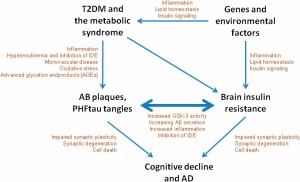Introducing the problem
As advanced as modern medicine is, there are still anomalies which have the scientific community confused. Increasingly Alzheimer’s disease is gaining attention as it becomes more prevalent in society. While chronic diseases take a toll on the patient, there are few more devastating than Alzheimer’s. Friends and family have to sit on the sideline and watch as loved ones deteriorate into an unrecognizable shell of their former self. While we wait for a pharmacologic silver bullet, there are ways to buy time. By simply understanding the basics of the disease we can make lifestyle changes to swing the odds in our favor.
Getting to the root of the problem
To understand Alzheimer’s, you must understand Amyloid plaques and Neurofibrillary tangles (NFTs). These are the two physiologic trademarks of Alzheimer’s. They stimulate changes in the brain like neuroinflammation and neural cell death. The question we ask then is about the origin of these dysfunctions in the brain. Research is pointing in the same direction as the well-known disease Diabetes.
Insulin is a hormone in the blood which helps regulate blood sugar levels by breaking down glucose and redistributing it as energy throughout the body. Insulin resistance occurs when there is consistently too much sugar in the blood stream and the body’s cells begin to react differently to the hormone. In the body this is the hallmark cause of type 2 diabetes, in the brain it may be the leading cause of Alzheimer’s.
Insulin resistance and its affects
In the brain, insulin resistance affects different signaling pathways which normally have healthy regulation and affects. When insulin receptors are bonded PI3K is activated, this leads to the activation of the protein kinase AKT which inhibits GSK-3B. Conversely, PI3K disruption is responsible for the hyperphosphorylation of TAU proteins, which are the main component of NFTs. Also, when GSK is not activated it leads to the deposition of Amyloid plaques. This is not the only pathway affected by insulin resistance. The MTOR pathway is activated by PI3K and its normal function is healthy, when disrupted it leads to TAU phosphorylation and AD pathogenesis. “Insulin resistance boosts the detrimental forces like oxidative stress, cytokines production, and apoptotic process. These phenomena instigate the neurodegenerative process causing impairment in memory and cognitive behavior”-https://moodle.cord.edu/pluginfile.php/1052906/mod_resource/content/1/insulin%20signaling%20and%20AD%202020.pdf
While we cannot directly control the signaling pathways in our brain, we can control our blood sugar levels by eating healthier and being more active. There are also other external risk factors we can limit to help reduce the odds of developing AD. Oxidative stress caused by fatty diets can cause neuroinflammation. There are also correlational studies linking stressful lifestyles, specifically occupations, to increased chances of developing AD. The most important external factor we cannot control. Age is the biggest risk as we see the eventual death of brain cells with aging.
Conclusion
While there is no magic pill a person can take to cure Alzheimer’s there are things a person can do to help limit your chances of developing this terrible disease. Being mindful about diet, exercise, and personal stress levels can increase your chances of growing old without losing your memory.